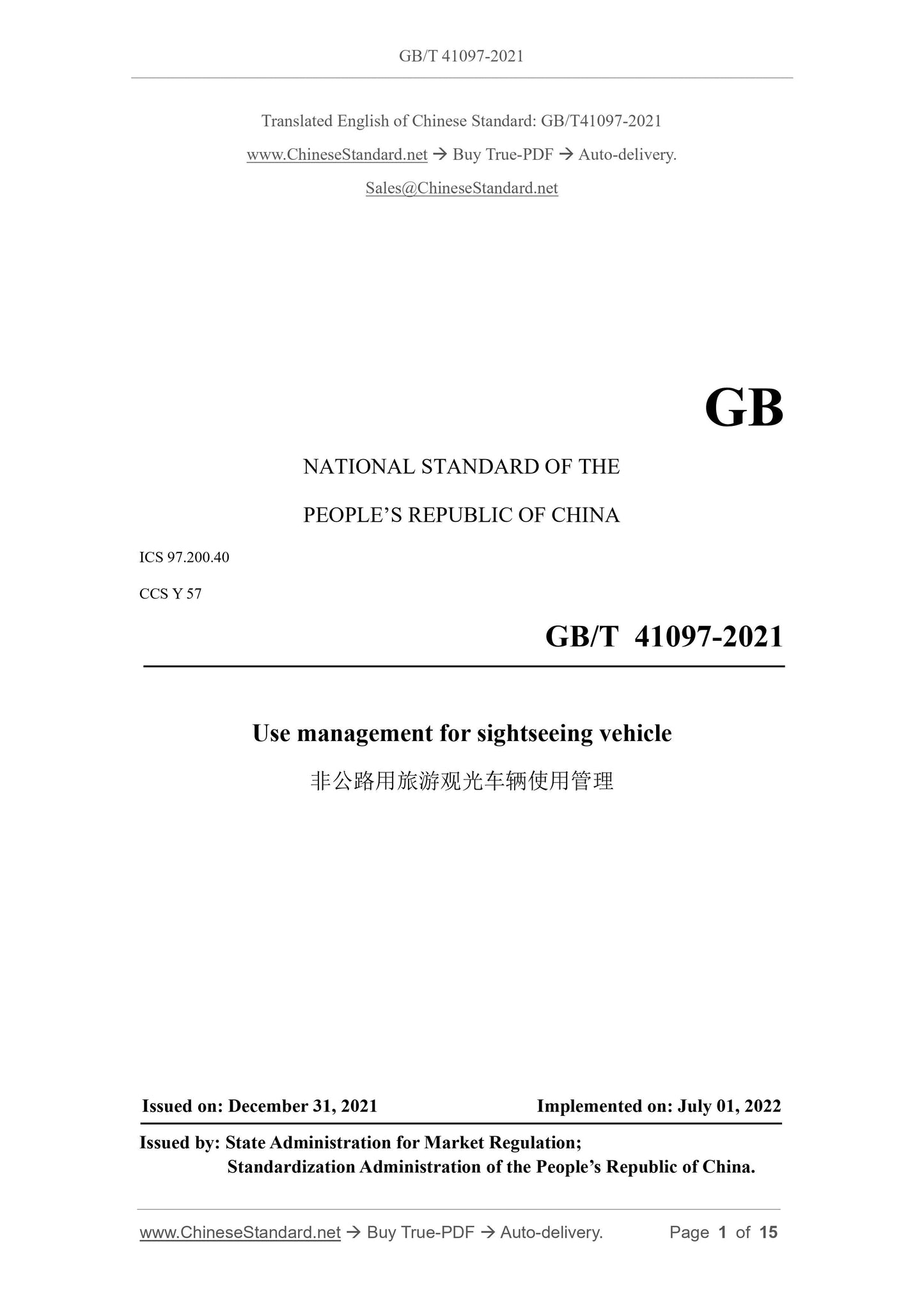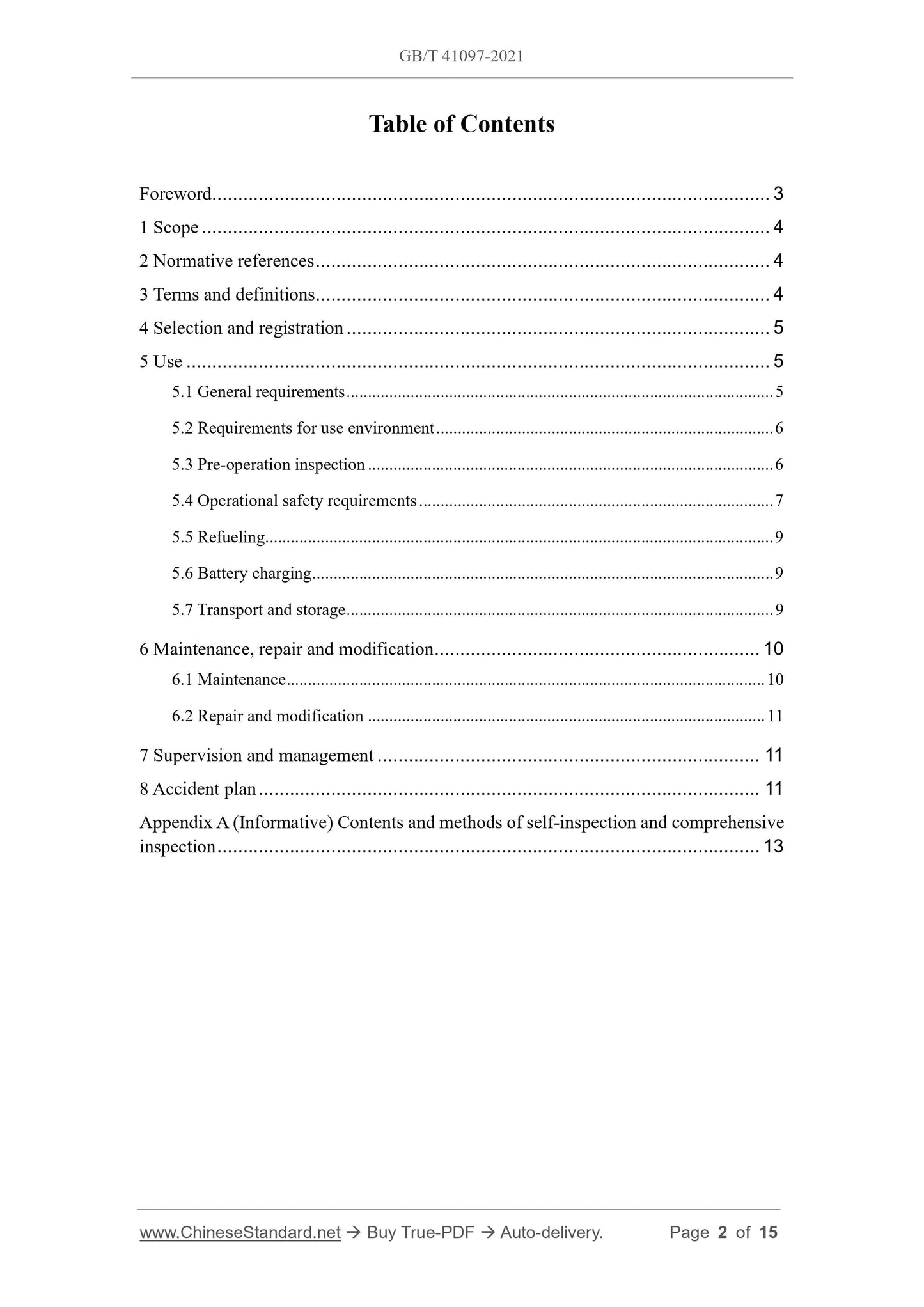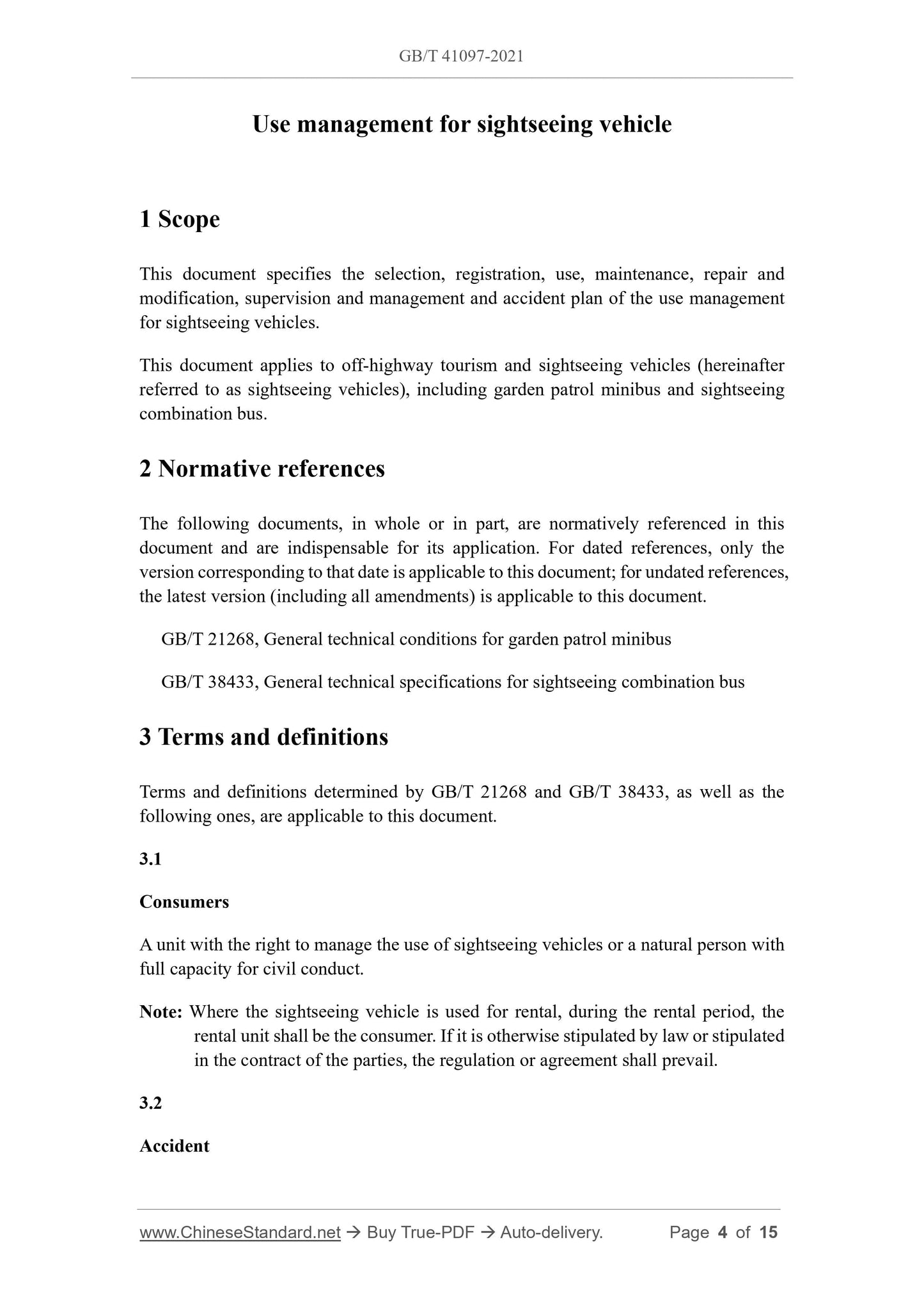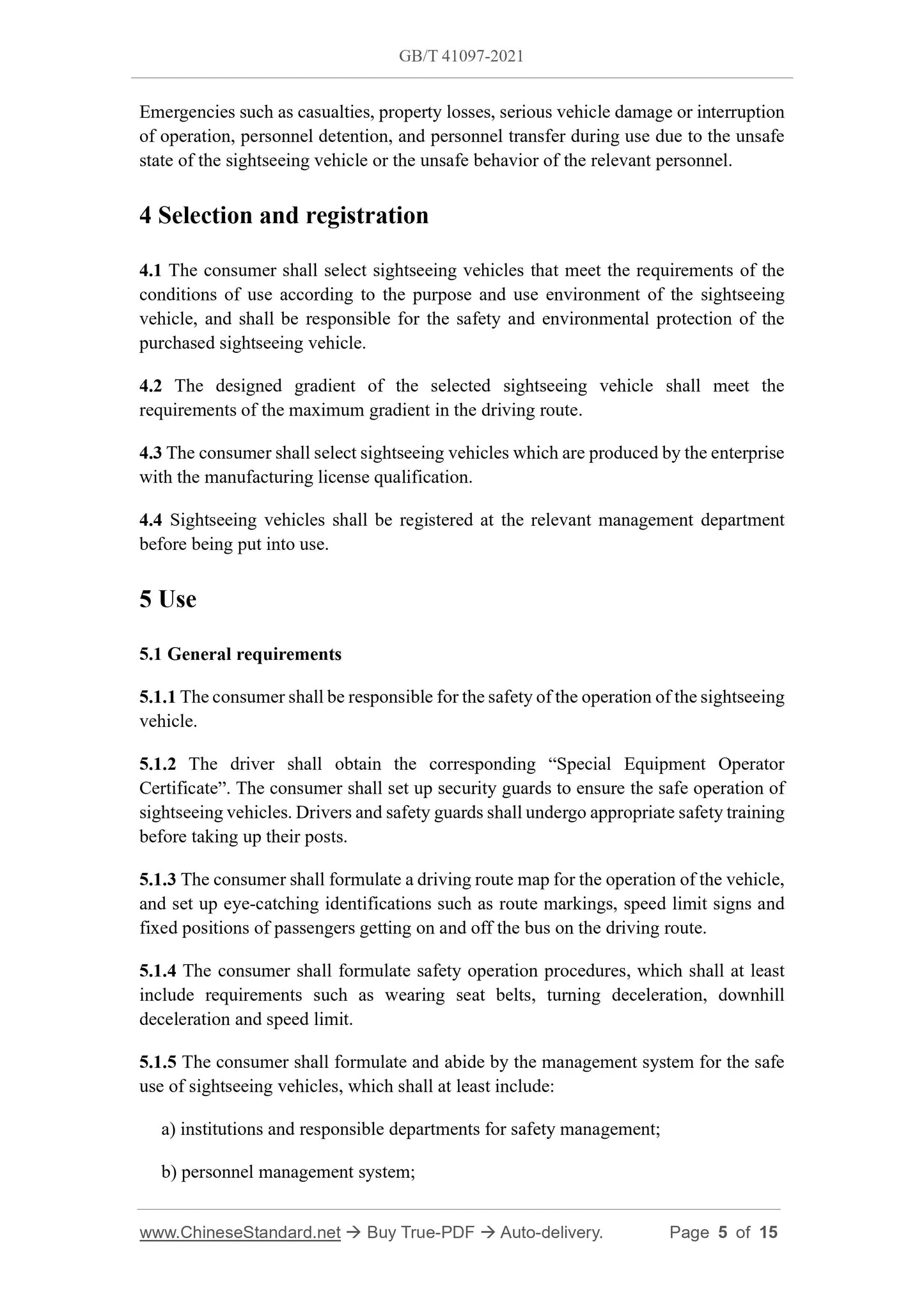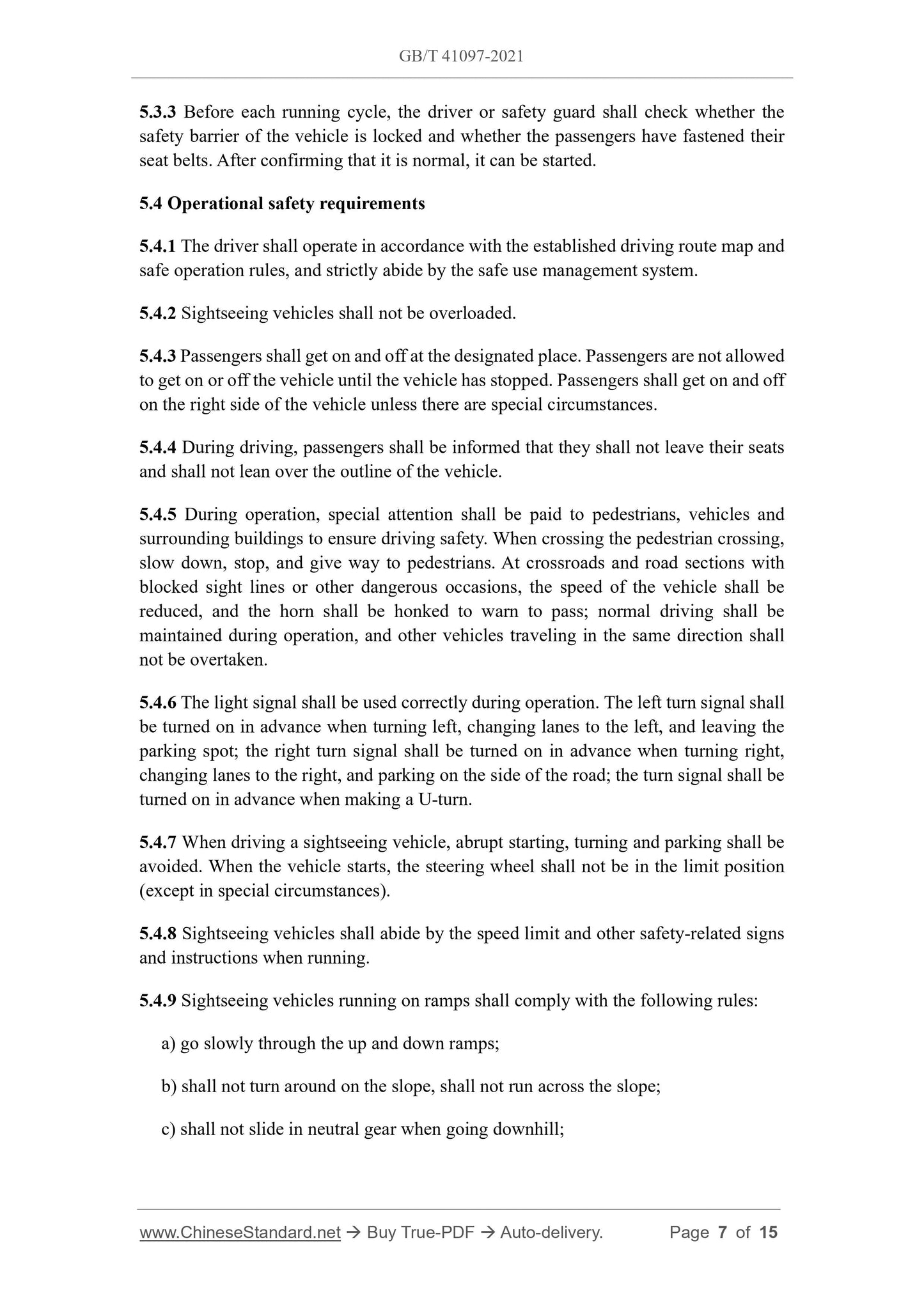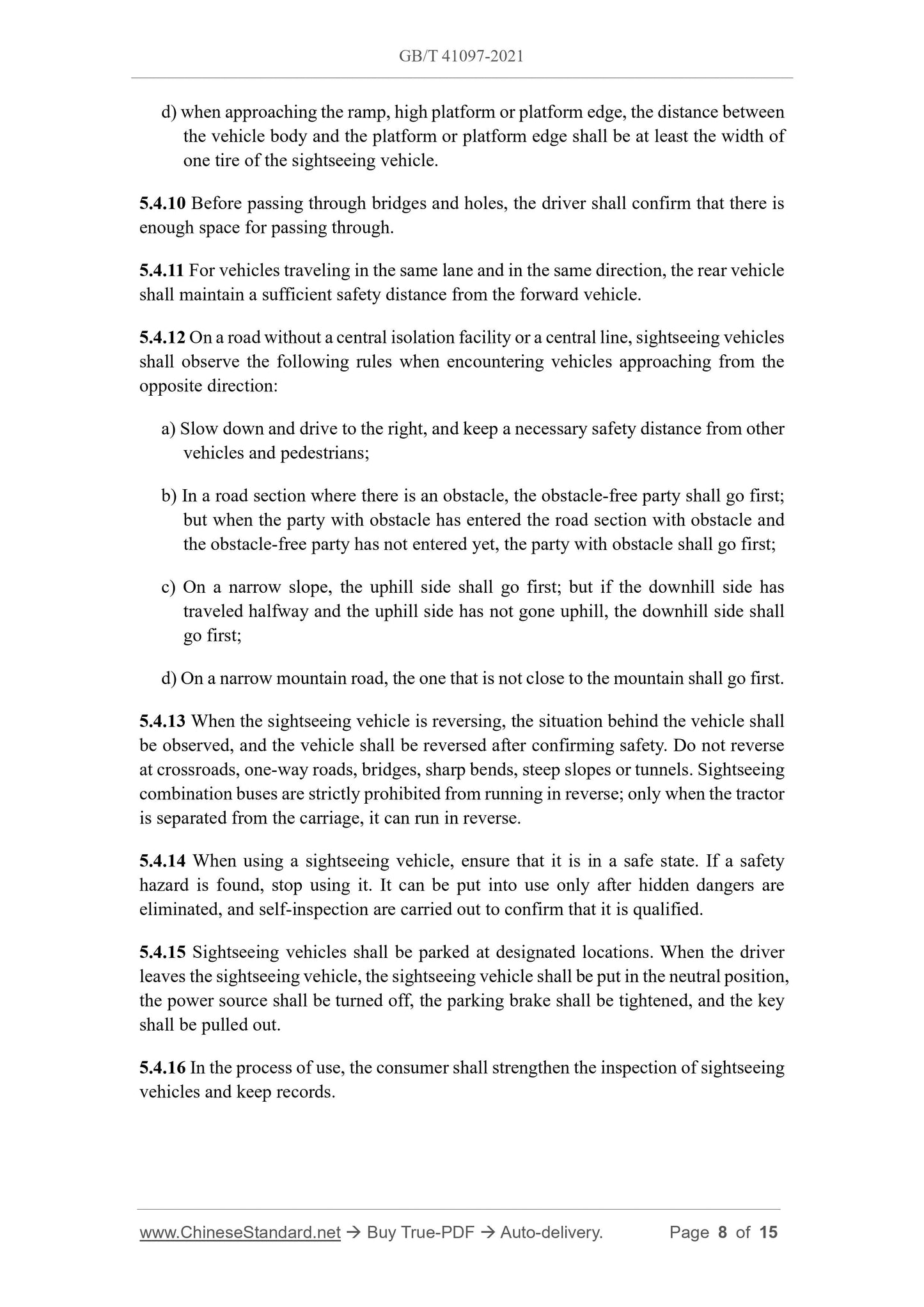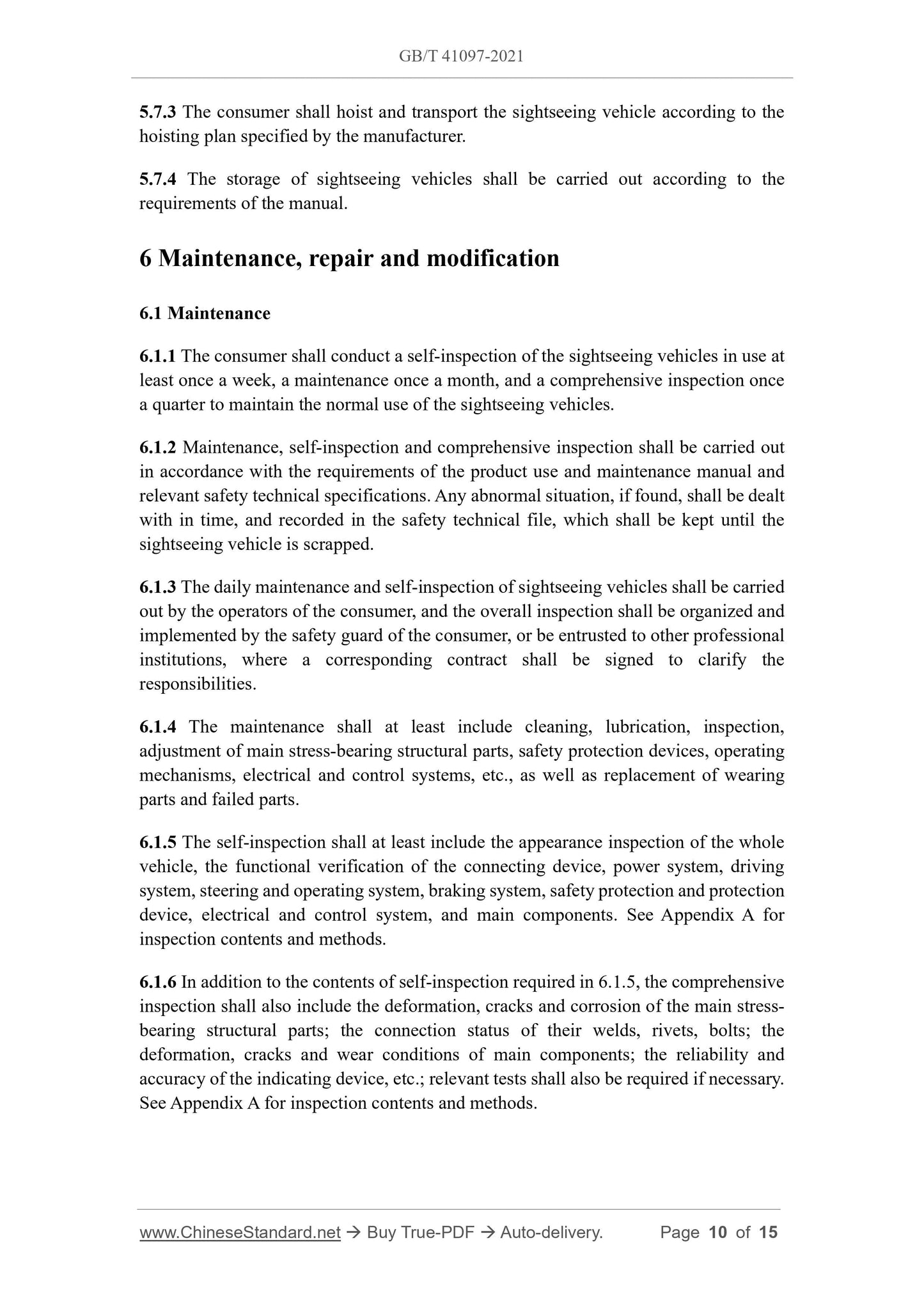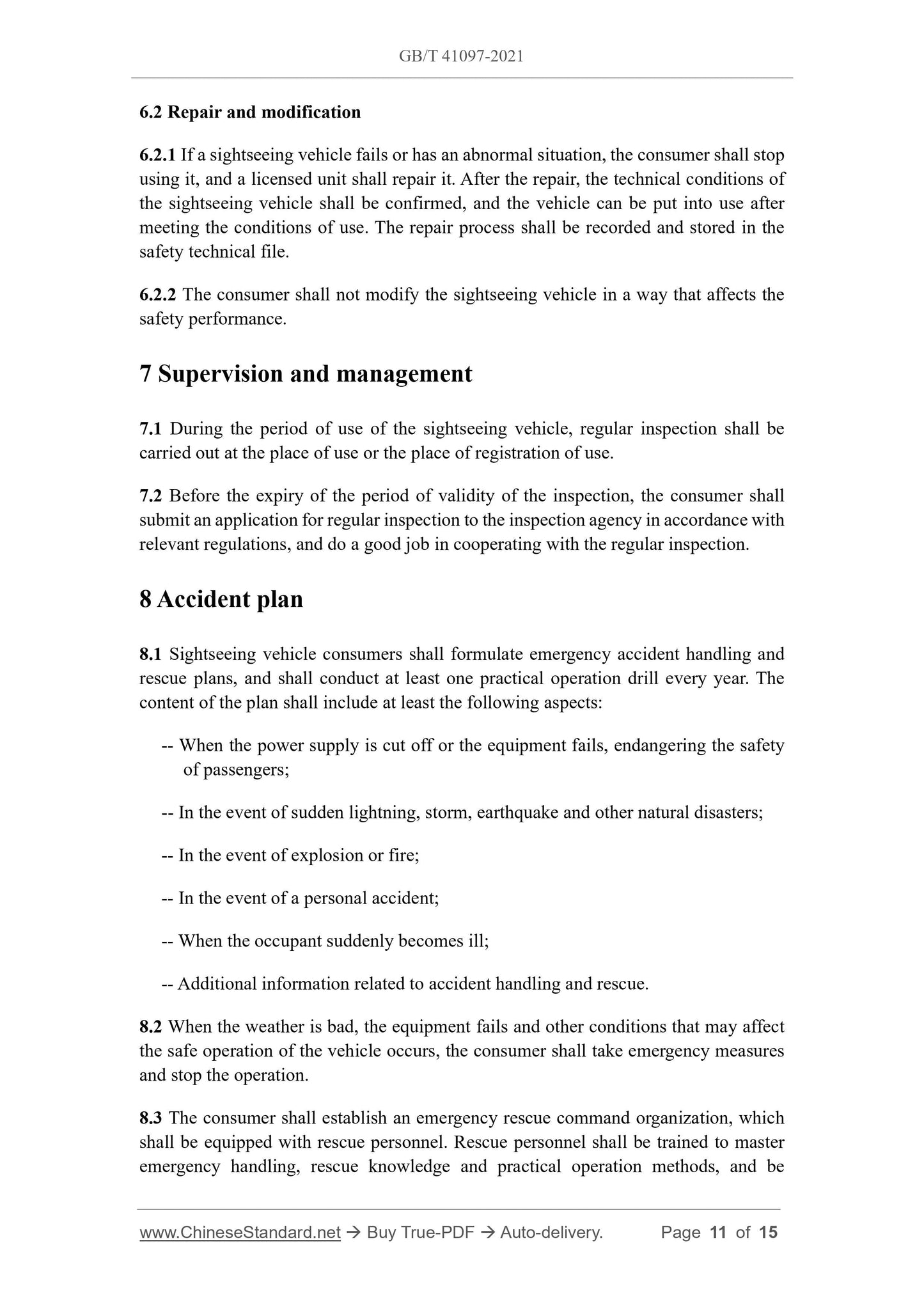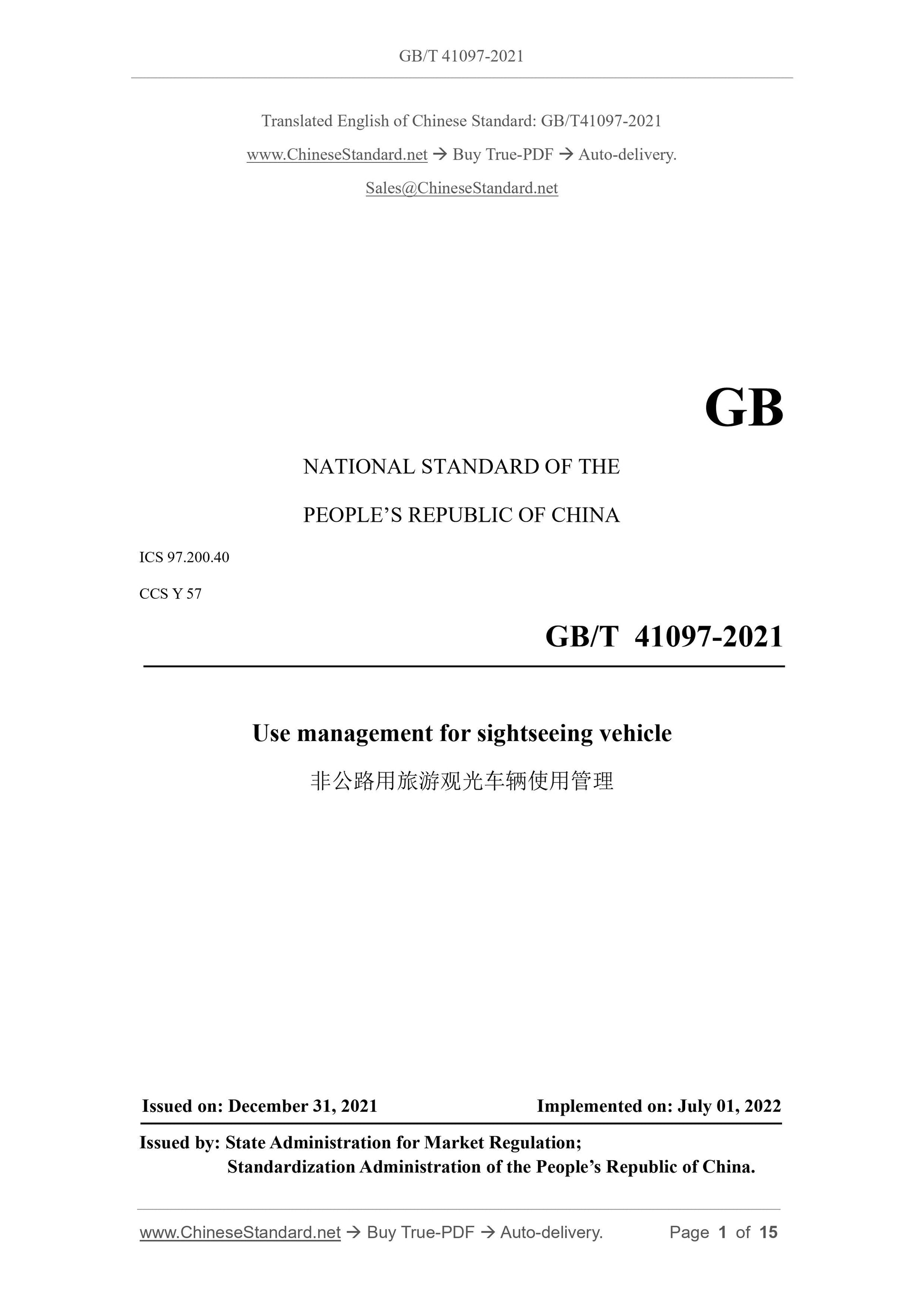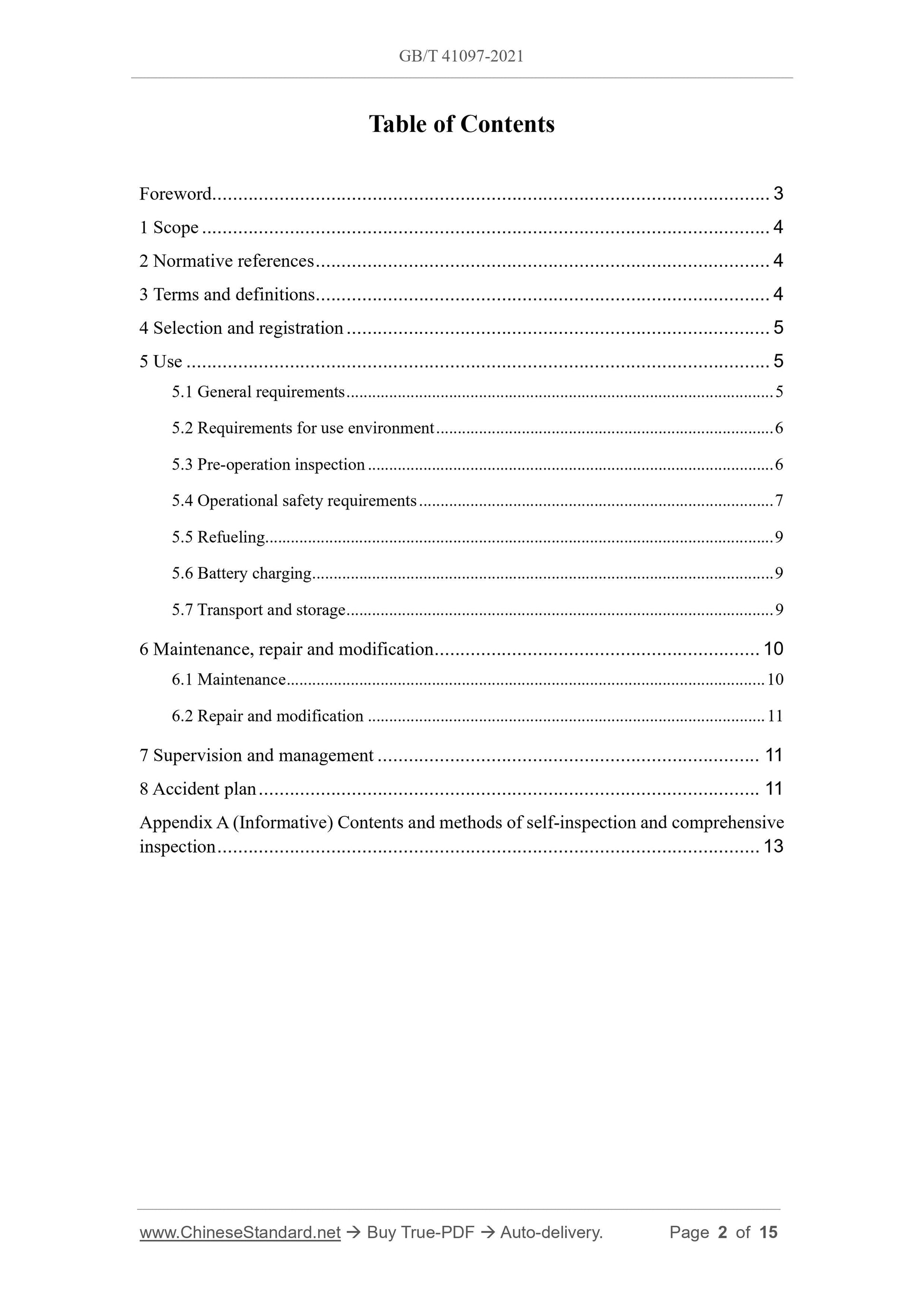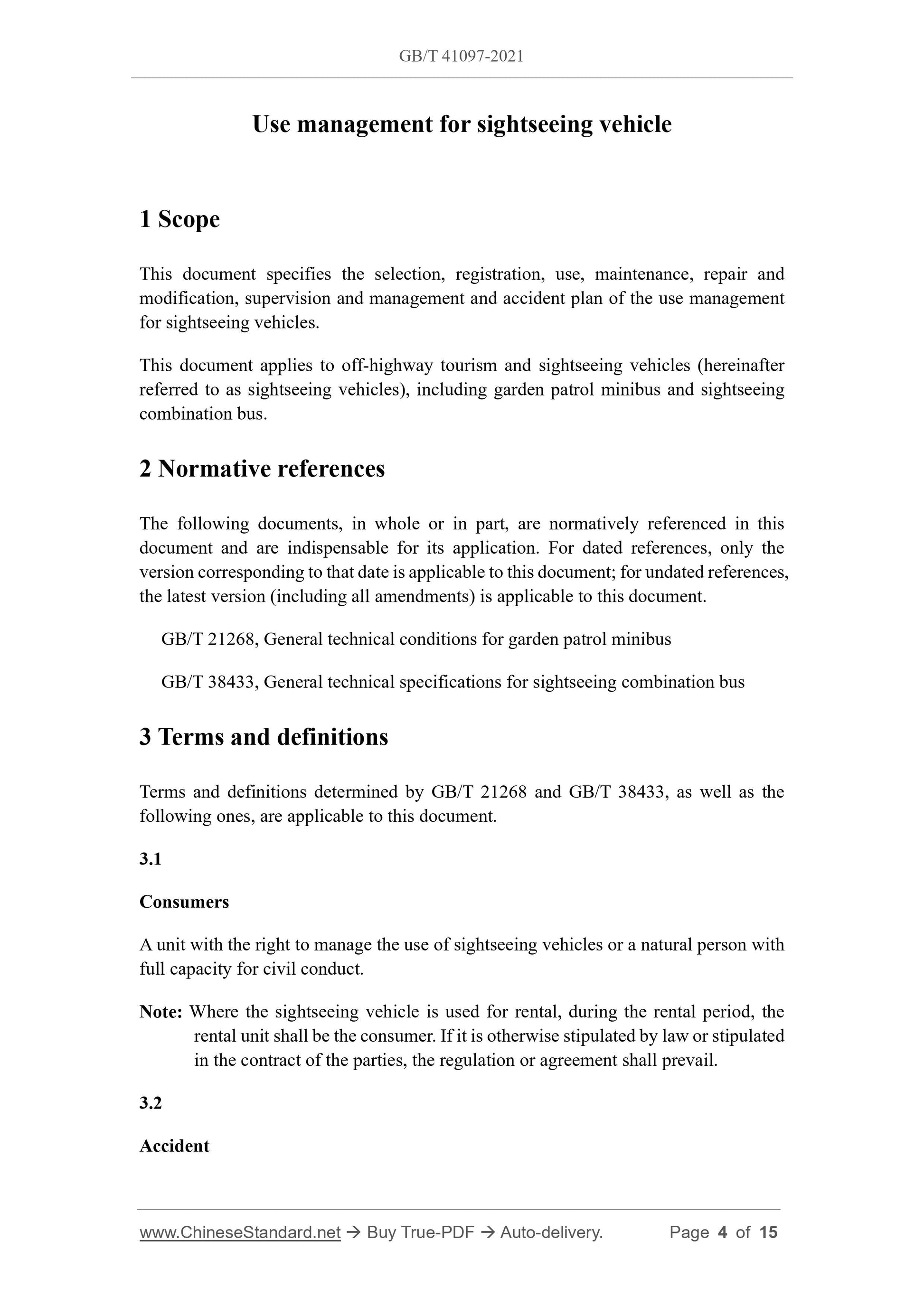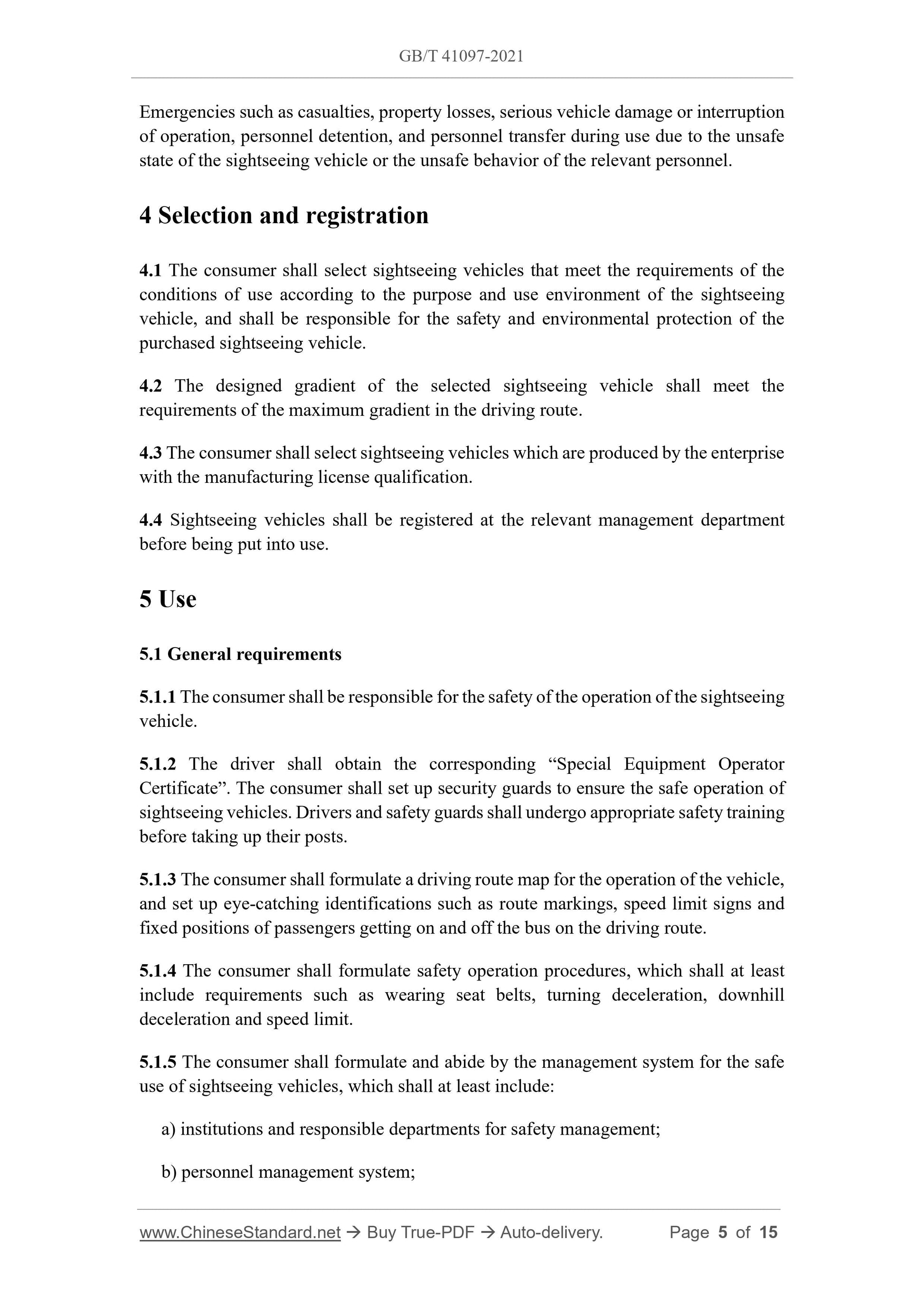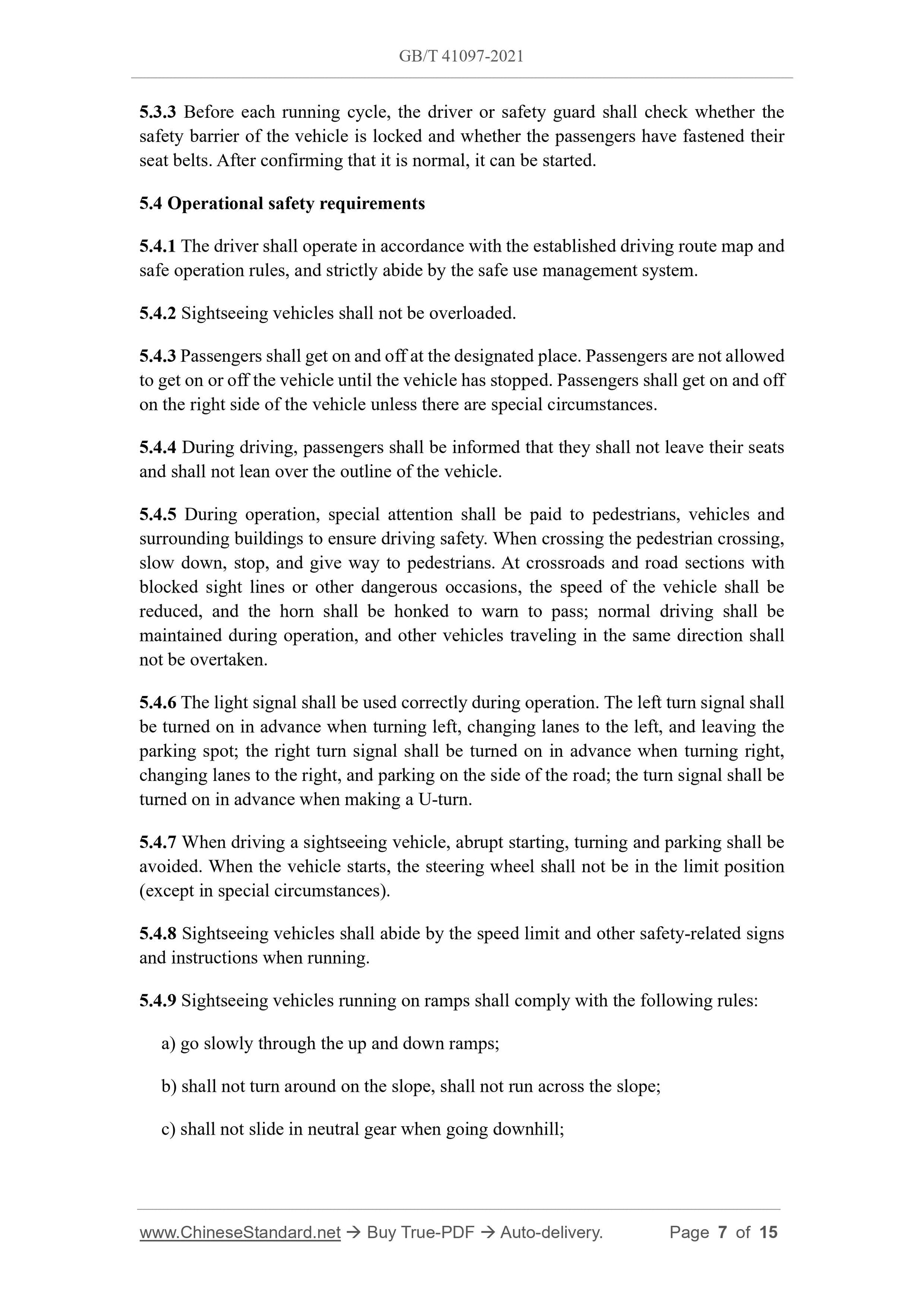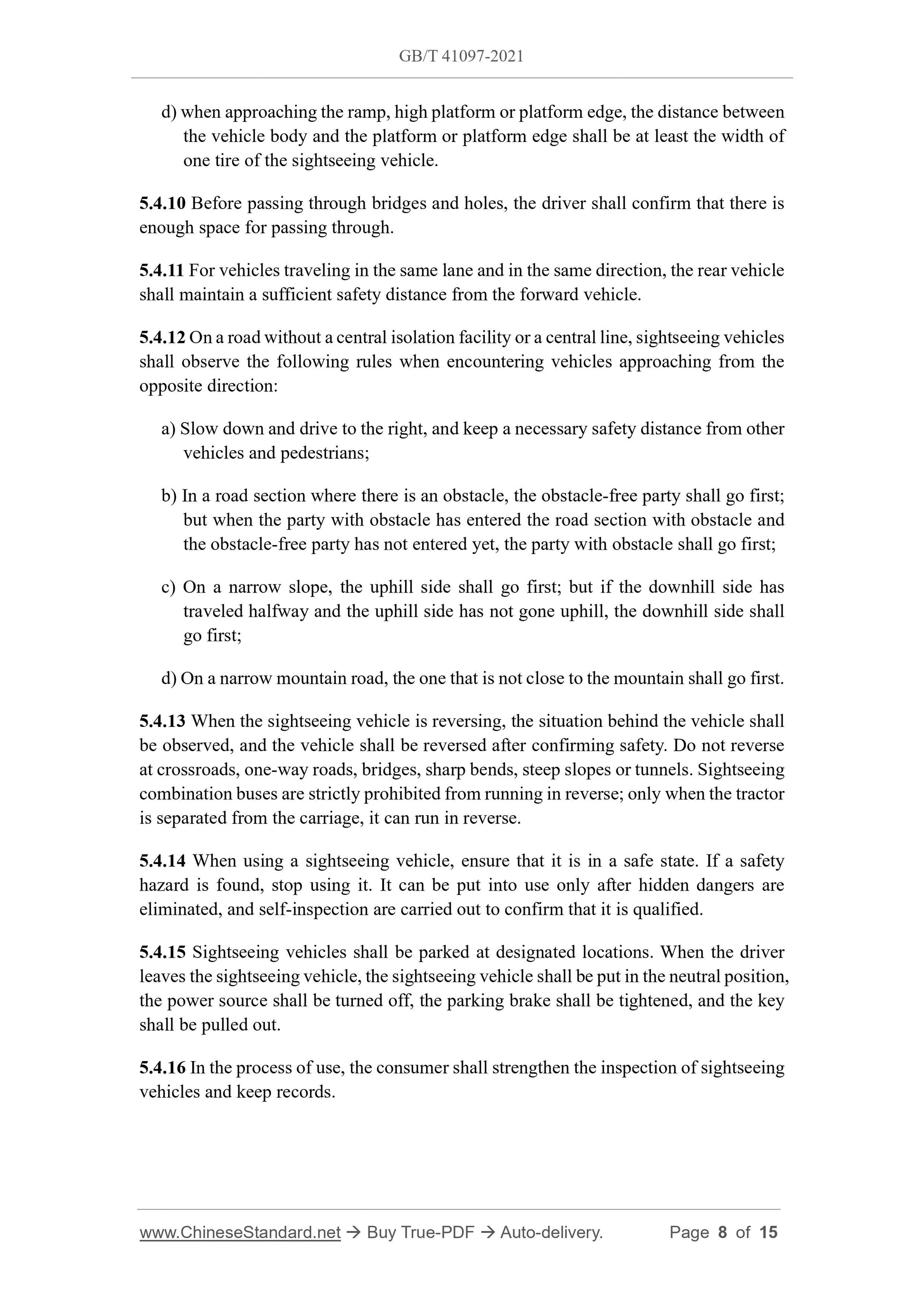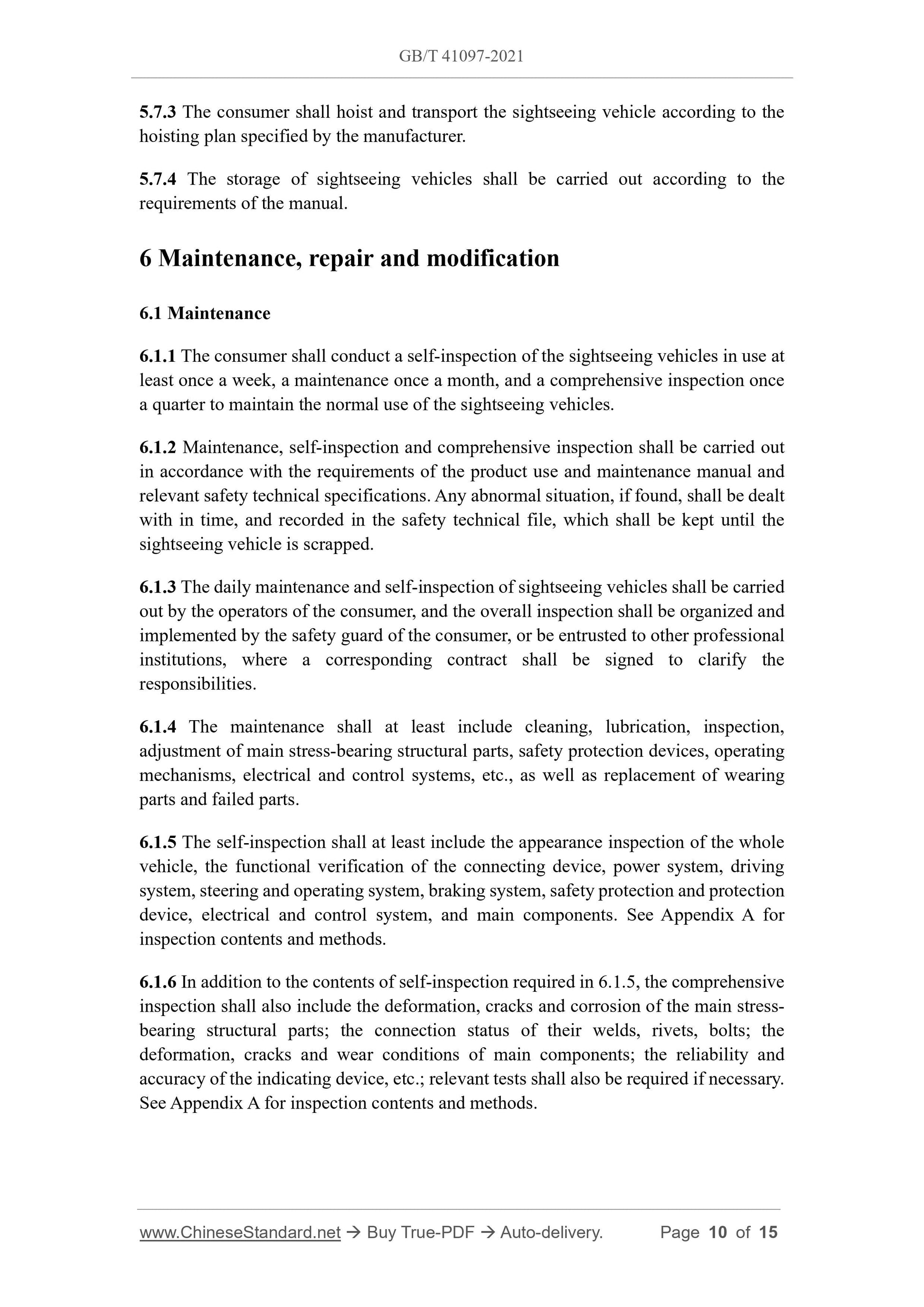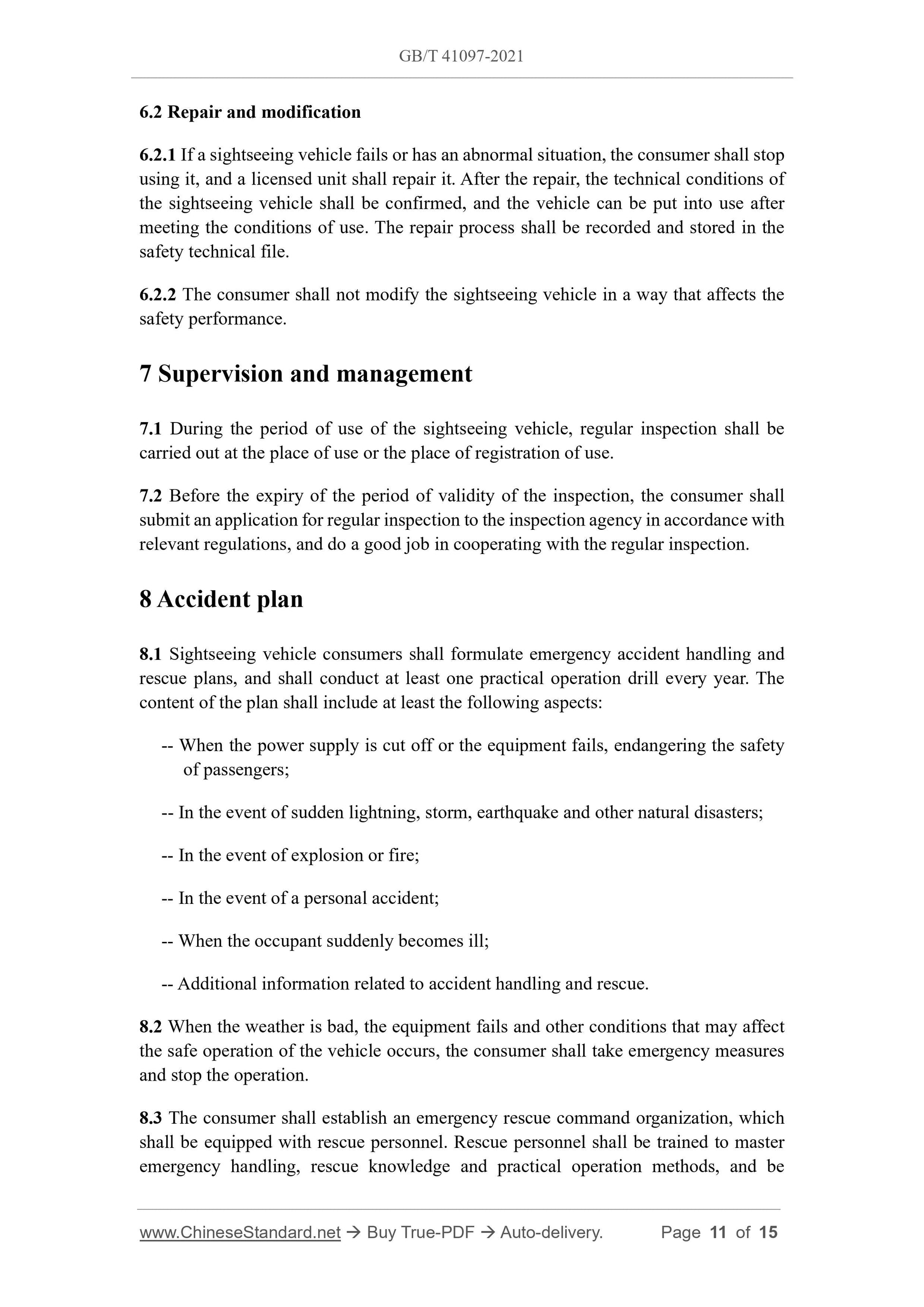1
/
of
8
PayPal, credit cards. Download editable-PDF & invoice in 1 second!
GB/T 41097-2021 English PDF (GBT41097-2021)
GB/T 41097-2021 English PDF (GBT41097-2021)
Regular price
$170.00 USD
Regular price
Sale price
$170.00 USD
Unit price
/
per
Shipping calculated at checkout.
Couldn't load pickup availability
Delivery: 3 seconds. Download true-PDF + Invoice.
Get QUOTATION in 1-minute: Click GB/T 41097-2021
Historical versions: GB/T 41097-2021
Preview True-PDF (Reload/Scroll if blank)
GB/T 41097-2021: Use management for sightseeing vehicle
GB/T 41097-2021
NATIONAL STANDARD OF THE
PEOPLE’S REPUBLIC OF CHINA
ICS 97.200.40
CCS Y 57
Use management for sightseeing vehicle
ISSUED ON: DECEMBER 31, 2021
IMPLEMENTED ON: JULY 01, 2022
Issued by: State Administration for Market Regulation;
Standardization Administration of the People’s Republic of China.
Table of Contents
Foreword ... 3
1 Scope ... 4
2 Normative references ... 4
3 Terms and definitions... 4
4 Selection and registration ... 5
5 Use ... 5
5.1 General requirements ... 5
5.2 Requirements for use environment ... 6
5.3 Pre-operation inspection ... 6
5.4 Operational safety requirements ... 7
5.5 Refueling ... 9
5.6 Battery charging ... 9
5.7 Transport and storage ... 9
6 Maintenance, repair and modification ... 10
6.1 Maintenance ... 10
6.2 Repair and modification ... 11
7 Supervision and management ... 11
8 Accident plan ... 11
Appendix A (Informative) Contents and methods of self-inspection and comprehensive
inspection ... 13
Use management for sightseeing vehicle
1 Scope
This document specifies the selection, registration, use, maintenance, repair and
modification, supervision and management and accident plan of the use management
for sightseeing vehicles.
This document applies to off-highway tourism and sightseeing vehicles (hereinafter
referred to as sightseeing vehicles), including garden patrol minibus and sightseeing
combination bus.
2 Normative references
The following documents, in whole or in part, are normatively referenced in this
document and are indispensable for its application. For dated references, only the
version corresponding to that date is applicable to this document; for undated references,
the latest version (including all amendments) is applicable to this document.
GB/T 21268, General technical conditions for garden patrol minibus
GB/T 38433, General technical specifications for sightseeing combination bus
3 Terms and definitions
Terms and definitions determined by GB/T 21268 and GB/T 38433, as well as the
following ones, are applicable to this document.
3.1
Consumers
A unit with the right to manage the use of sightseeing vehicles or a natural person with
full capacity for civil conduct.
Note: Where the sightseeing vehicle is used for rental, during the rental period, the
rental unit shall be the consumer. If it is otherwise stipulated by law or stipulated
in the contract of the parties, the regulation or agreement shall prevail.
3.2
Accident
Emergencies such as casualties, property losses, serious vehicle damage or interruption
of operation, personnel detention, and personnel transfer during use due to the unsafe
state of the sightseeing vehicle or the unsafe behavior of the relevant personnel.
4 Selection and registration
4.1 The consumer shall select sightseeing vehicles that meet the requirements of the
conditions of use according to the purpose and use environment of the sightseeing
vehicle, and shall be responsible for the safety and environmental protection of the
purchased sightseeing vehicle.
4.2 The designed gradient of the selected sightseeing vehicle shall meet the
requirements of the maximum gradient in the driving route.
4.3 The consumer shall select sightseeing vehicles which are produced by the enterprise
with the manufacturing license qualification.
4.4 Sightseeing vehicles shall be registered at the relevant management department
before being put into use.
5 Use
5.1 General requirements
5.1.1 The consumer shall be responsible for the safety of the operation of the sightseeing
vehicle.
5.1.2 The driver shall obtain the corresponding “Special Equipment Operator
Certificate”. The consumer shall set up security guards to ensure the safe operation of
sightseeing vehicles. Drivers and safety guards shall undergo appropriate safety training
before taking up their posts.
5.1.3 The consumer shall formulate a driving route map for the operation of the vehicle,
and set up eye-catching identifications such as route markings, speed limit signs and
fixed positions of passengers getting on and off the bus on the driving route.
5.1.4 The consumer shall formulate safety operation procedures, which shall at least
include requirements such as wearing seat belts, turning deceleration, downhill
deceleration and speed limit.
5.1.5 The consumer shall formulate and abide by the management system for the safe
use of sightseeing vehicles, which shall at least include:
a) institutions and responsible departments for safety management;
b) personnel management system;
5.3.3 Before each running cycle, the driver or safety guard shall check whether the
safety barrier of the vehicle is locked and whether the passengers have fastened their
seat belts. After confirming that it is normal, it can be started.
5.4 Operational safety requirements
5.4.1 The driver shall operate in accordance with the established driving route map and
safe operation rules, and strictly abide by the safe use management system.
5.4.2 Sightseeing vehicles shall not be overloaded.
5.4.3 Passengers shall get on and off at the designated place. Passengers are not allowed
to get on or off the vehicle until the vehicle has stopped. Passengers shall get on and off
on the right side of the vehicle unless there are special circumstances.
5.4.4 During driving, passengers shall be informed that they shall not leave their seats
and shall not lean over the outline of the vehicle.
5.4.5 During operation, special attention shall be paid to pedestrians, vehicles and
surrounding buildings to ensure driving safety. When crossing the pedestrian crossing,
slow down, stop, and give way to pedestrians. At crossroads and road sections with
blocked sight lines or other dangerous occasions, the speed of the vehicle shall be
reduced, and the horn shall be honked to warn to pass; normal driving shall be
maintained during operation, and other vehicles traveling in the same direction shall
not be overtaken.
5.4.6 The light signal shall be used correctly during operation. The left turn signal shall
be turned on in advance when turning left, changing lanes to the left, and leaving the
parking spot; the right turn signal shall be turned on in advance when turning right,
changing lanes to the right, and parking on the side of the road; the turn signal shall be
turned on in advance when making a U-turn.
5.4.7 When driving a sightseeing vehicle, abrupt starting, turning and parking shall be
avoided. When the vehicle starts, the steering wheel shall not be in the limit position
(except in special circumstances).
5.4.8 Sightseeing vehicles shall abide by the speed limit and other safety-related signs
and instructions when running.
5.4.9 Sightseeing vehicles running on ramps shall comply with the following rules:
a) go slowly through the up and down ramps;
b) shall not turn around on the slope, shall not run across the slope;
c) shall not slide in neutral gear when going downhill;
d) when approaching the ramp, high platform or platform edge, the distance between
the vehicle body and the platform or platform edge shall be at least the width of
one tire of the sightseeing vehicle.
5.4.10 Before passing through bridges and holes, the driver shall confirm that there is
enough space for passing through.
5.4.11 For vehicles traveling in the same lane and in the same direction, the rear vehicle
shall maintain a sufficient safety distance from ...
Get QUOTATION in 1-minute: Click GB/T 41097-2021
Historical versions: GB/T 41097-2021
Preview True-PDF (Reload/Scroll if blank)
GB/T 41097-2021: Use management for sightseeing vehicle
GB/T 41097-2021
NATIONAL STANDARD OF THE
PEOPLE’S REPUBLIC OF CHINA
ICS 97.200.40
CCS Y 57
Use management for sightseeing vehicle
ISSUED ON: DECEMBER 31, 2021
IMPLEMENTED ON: JULY 01, 2022
Issued by: State Administration for Market Regulation;
Standardization Administration of the People’s Republic of China.
Table of Contents
Foreword ... 3
1 Scope ... 4
2 Normative references ... 4
3 Terms and definitions... 4
4 Selection and registration ... 5
5 Use ... 5
5.1 General requirements ... 5
5.2 Requirements for use environment ... 6
5.3 Pre-operation inspection ... 6
5.4 Operational safety requirements ... 7
5.5 Refueling ... 9
5.6 Battery charging ... 9
5.7 Transport and storage ... 9
6 Maintenance, repair and modification ... 10
6.1 Maintenance ... 10
6.2 Repair and modification ... 11
7 Supervision and management ... 11
8 Accident plan ... 11
Appendix A (Informative) Contents and methods of self-inspection and comprehensive
inspection ... 13
Use management for sightseeing vehicle
1 Scope
This document specifies the selection, registration, use, maintenance, repair and
modification, supervision and management and accident plan of the use management
for sightseeing vehicles.
This document applies to off-highway tourism and sightseeing vehicles (hereinafter
referred to as sightseeing vehicles), including garden patrol minibus and sightseeing
combination bus.
2 Normative references
The following documents, in whole or in part, are normatively referenced in this
document and are indispensable for its application. For dated references, only the
version corresponding to that date is applicable to this document; for undated references,
the latest version (including all amendments) is applicable to this document.
GB/T 21268, General technical conditions for garden patrol minibus
GB/T 38433, General technical specifications for sightseeing combination bus
3 Terms and definitions
Terms and definitions determined by GB/T 21268 and GB/T 38433, as well as the
following ones, are applicable to this document.
3.1
Consumers
A unit with the right to manage the use of sightseeing vehicles or a natural person with
full capacity for civil conduct.
Note: Where the sightseeing vehicle is used for rental, during the rental period, the
rental unit shall be the consumer. If it is otherwise stipulated by law or stipulated
in the contract of the parties, the regulation or agreement shall prevail.
3.2
Accident
Emergencies such as casualties, property losses, serious vehicle damage or interruption
of operation, personnel detention, and personnel transfer during use due to the unsafe
state of the sightseeing vehicle or the unsafe behavior of the relevant personnel.
4 Selection and registration
4.1 The consumer shall select sightseeing vehicles that meet the requirements of the
conditions of use according to the purpose and use environment of the sightseeing
vehicle, and shall be responsible for the safety and environmental protection of the
purchased sightseeing vehicle.
4.2 The designed gradient of the selected sightseeing vehicle shall meet the
requirements of the maximum gradient in the driving route.
4.3 The consumer shall select sightseeing vehicles which are produced by the enterprise
with the manufacturing license qualification.
4.4 Sightseeing vehicles shall be registered at the relevant management department
before being put into use.
5 Use
5.1 General requirements
5.1.1 The consumer shall be responsible for the safety of the operation of the sightseeing
vehicle.
5.1.2 The driver shall obtain the corresponding “Special Equipment Operator
Certificate”. The consumer shall set up security guards to ensure the safe operation of
sightseeing vehicles. Drivers and safety guards shall undergo appropriate safety training
before taking up their posts.
5.1.3 The consumer shall formulate a driving route map for the operation of the vehicle,
and set up eye-catching identifications such as route markings, speed limit signs and
fixed positions of passengers getting on and off the bus on the driving route.
5.1.4 The consumer shall formulate safety operation procedures, which shall at least
include requirements such as wearing seat belts, turning deceleration, downhill
deceleration and speed limit.
5.1.5 The consumer shall formulate and abide by the management system for the safe
use of sightseeing vehicles, which shall at least include:
a) institutions and responsible departments for safety management;
b) personnel management system;
5.3.3 Before each running cycle, the driver or safety guard shall check whether the
safety barrier of the vehicle is locked and whether the passengers have fastened their
seat belts. After confirming that it is normal, it can be started.
5.4 Operational safety requirements
5.4.1 The driver shall operate in accordance with the established driving route map and
safe operation rules, and strictly abide by the safe use management system.
5.4.2 Sightseeing vehicles shall not be overloaded.
5.4.3 Passengers shall get on and off at the designated place. Passengers are not allowed
to get on or off the vehicle until the vehicle has stopped. Passengers shall get on and off
on the right side of the vehicle unless there are special circumstances.
5.4.4 During driving, passengers shall be informed that they shall not leave their seats
and shall not lean over the outline of the vehicle.
5.4.5 During operation, special attention shall be paid to pedestrians, vehicles and
surrounding buildings to ensure driving safety. When crossing the pedestrian crossing,
slow down, stop, and give way to pedestrians. At crossroads and road sections with
blocked sight lines or other dangerous occasions, the speed of the vehicle shall be
reduced, and the horn shall be honked to warn to pass; normal driving shall be
maintained during operation, and other vehicles traveling in the same direction shall
not be overtaken.
5.4.6 The light signal shall be used correctly during operation. The left turn signal shall
be turned on in advance when turning left, changing lanes to the left, and leaving the
parking spot; the right turn signal shall be turned on in advance when turning right,
changing lanes to the right, and parking on the side of the road; the turn signal shall be
turned on in advance when making a U-turn.
5.4.7 When driving a sightseeing vehicle, abrupt starting, turning and parking shall be
avoided. When the vehicle starts, the steering wheel shall not be in the limit position
(except in special circumstances).
5.4.8 Sightseeing vehicles shall abide by the speed limit and other safety-related signs
and instructions when running.
5.4.9 Sightseeing vehicles running on ramps shall comply with the following rules:
a) go slowly through the up and down ramps;
b) shall not turn around on the slope, shall not run across the slope;
c) shall not slide in neutral gear when going downhill;
d) when approaching the ramp, high platform or platform edge, the distance between
the vehicle body and the platform or platform edge shall be at least the width of
one tire of the sightseeing vehicle.
5.4.10 Before passing through bridges and holes, the driver shall confirm that there is
enough space for passing through.
5.4.11 For vehicles traveling in the same lane and in the same direction, the rear vehicle
shall maintain a sufficient safety distance from ...
Share
